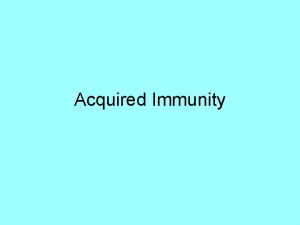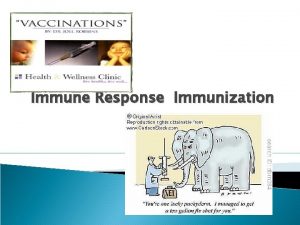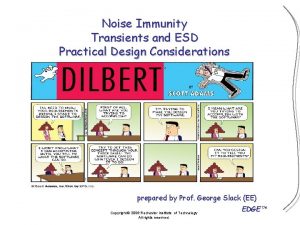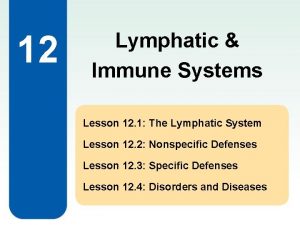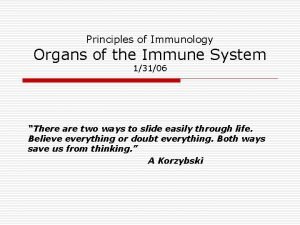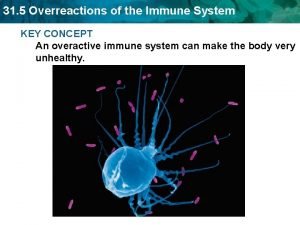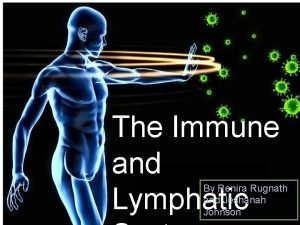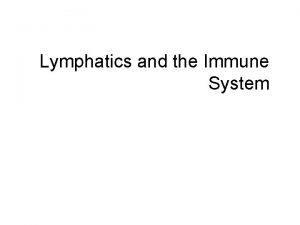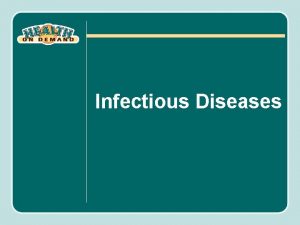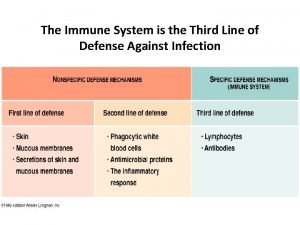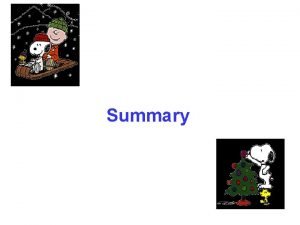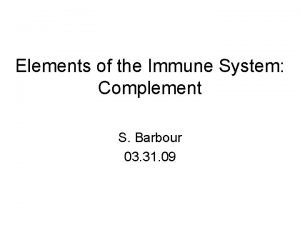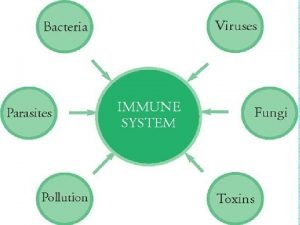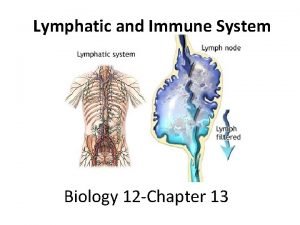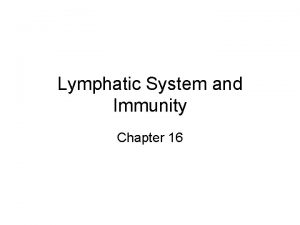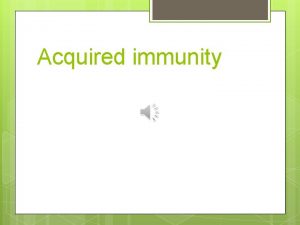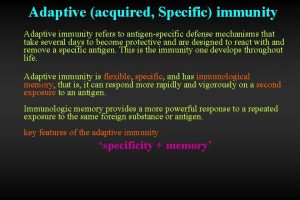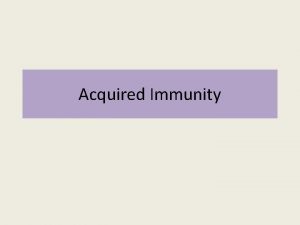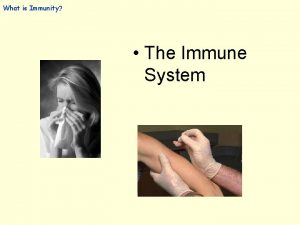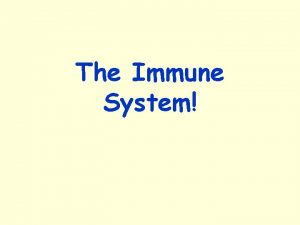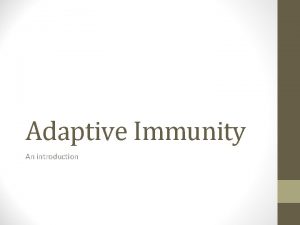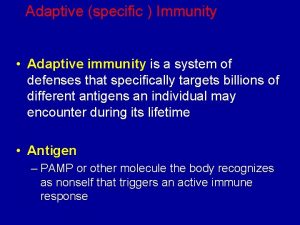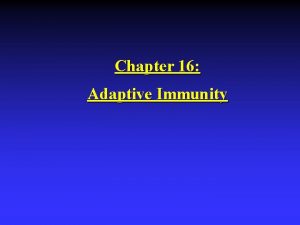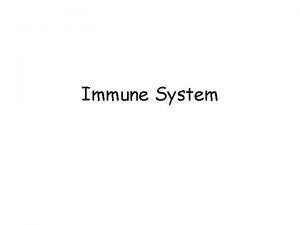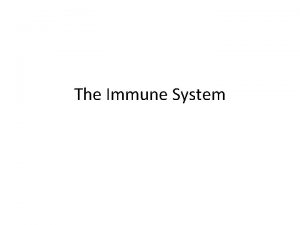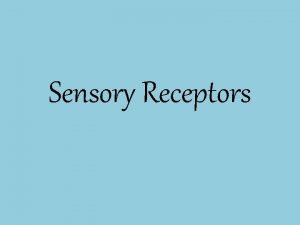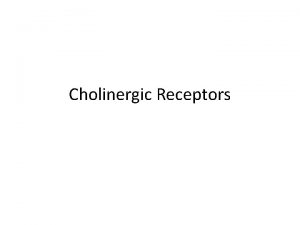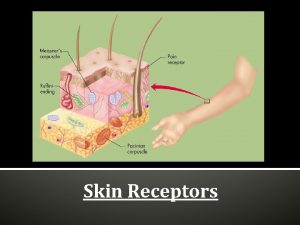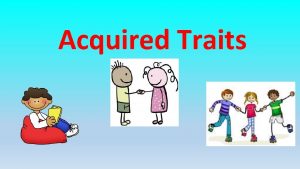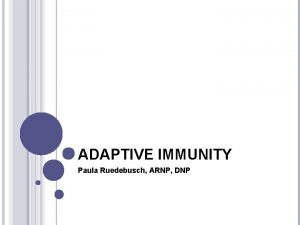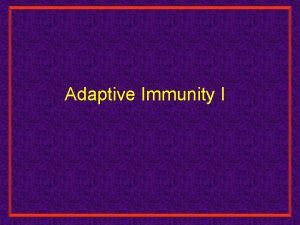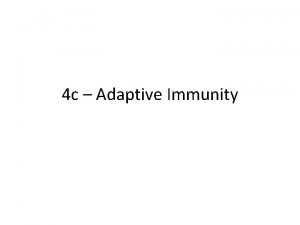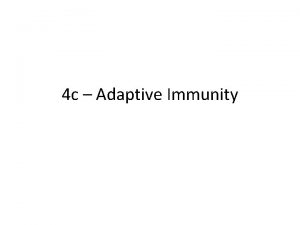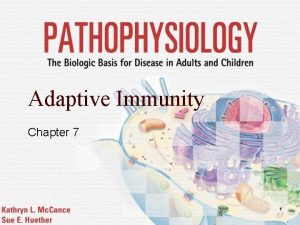Adaptive acquired Immune System In adaptive immunity receptors































- Slides: 31

Adaptive (acquired) Immune System

In adaptive immunity, receptors provide pathogen-specific recognition Lymphocytes: Originate from stem cells in bone marrow 1. B lymphocytes (B cells): Mature in bone marrow 2. T lymphocytes (T cells): Mature in thymus

• Lymphocytes recognize specific antigens: Large molecules on surface of foreign cells or viruses • B & T cells bind to antigens via proteins: Antigen receptors • Countless different antigen receptors but those made by single B or T cell are identical

B Cell Receptors • Y-shaped molecule with 4 polypeptide chains (2 heavy, 2 light) linked with disulfide bridges • One end anchored into cell’s membrane • Variable (V) regions • Constant (C) regions

B cell response: • Epitope (antigenic determinant): Small portion of antigen that binds to antigen receptor (lock & key) • Binding of receptor to antigen triggers secretion of soluble receptor: Antibody (immunoglobin, Ig)

T Cell Receptors • 2 polypeptide chains: a chain & b chain • Variable (V) regions at tips (1 antigen binding site) • Anchored in cell membrane

T Cell Response: • When a pathogen infects cell, enzymes inside cell cut antigen into smaller peptides (antigen fragments) • Fragments bind to MHC (major histocompatibility) molecules • Antigen presentation: MHC & bound antigen move to cell surface • T cell receptor binds to MHC/Antigen

1. 4 Characteristics of Adaptive Immunity Diversity: Large diversity of lymphocytes and receptors can detect new pathogens never encountered before

1. 4 Characteristics of Adaptive Immunity Diversity: Large diversity of lymphocytes and receptors can detect new pathogens never encountered before 2. Self tolerant: Not reactive against own cells

1. 4 Characteristics of Adaptive Immunity Diversity: Large diversity of lymphocytes and receptors can detect new pathogens never encountered before 2. Self tolerant: Not reactive against own cells 3. Clonal Selection: B & T cells multiple after being activated: Clonal selection creates clones (effector cells) • • B effector cells: Plasma cells that make antibodies T effector cells: Helper T cells and Cytotoxic T cells

Clonal Selection

1. 4 Characteristics of Adaptive Immunity Diversity: Large diversity of lymphocytes and receptors can detect new pathogens never encountered before 2. Self tolerant: Not reactive against own cells 3. Clonal Selection: B & T cells multiple after being activated: Clonal selection creates clones (effector cells) • • B effector cells: Plasma cells that make antibodies T effector cells: Helper T cells and Cytotoxic T cells 4. Immunological memory: Stronger and more rapid response to antigen already seen

Immunological Memory

Adaptive immunity defends against infection of body fluids and body cells 2 Types of Immune Response: 1. Humoral: Occurs in blood, lymph • Antibodies (immunoglobins, Ig) neutralize pathogens 2. Cell-mediated: Cytotoxic T cells destroy infected host cells

Helper T Cells • Antigen-presenting cell engulfs a pathogen, degrades it & displays antigen fragments complexed with class II MHC molecules (only on antigen-presenting cells) on the cell surface • Specific Helper T cell binds to this complex via its antigen receptor & an accessory protein, CD 4

Helper T Cells • Binding of helper T cell promotes cytokine secretion by antigen-presenting cell • Cytokines activate helper T cell and stimulates it’s proliferation

Helper T Cells • Cell proliferation produce clone of activated helper T cells • All cells in the clone have receptors for the same antigen fragment complex • Cells secrete cytokines which activate B cells and cytotoxic T cells

Humoral B Cell Activation

Humoral B Cell Activation

Humoral B Cell Activation

Antibodies Effect of Pathogens

Antibodies Effect of Pathogens

Antibodies Effect of Pathogens

Cell-mediated: Cytotoxic T Cells CD 8

Cell-mediated: Cytotoxic T Cells CD 8

Cell-mediated: Cytotoxic T Cells CD 8

Overview of Adaptive Immune Response

Disruptions in immune system function can elicit or exacerbate disease. • Allergies: Hypersensitive response to environmental antigens (allergens) • Anaphylactic shock: Extreme response that can lead to death

Autoimmune disease: When immune response active against molecules of own body, e. g. lupus, rheumatoid arthritis

Immunodeficiency: Reduced immune response to pathogens, e. g. Severe combined immunodeficiency (SCID) caused by lack of lymphocytes

Immunity • Active immunity: Clones of memory cells form when particular pathogen infects body • Passive immunity: Antibodies transferred from pregnant female to fetus (nursing continues protection) • Immunization (Vaccines): Deliberate introduction of antigens to stimulate immunological memory
 Difference between acquired immunity and innate immunity
Difference between acquired immunity and innate immunity A subsequent
A subsequent Acquired immunity
Acquired immunity Acquired immunity definition
Acquired immunity definition Acquired immunity
Acquired immunity Naturally acquired passive immunity definition
Naturally acquired passive immunity definition Tonsil
Tonsil Adaptive noise immunity
Adaptive noise immunity Immune
Immune What is the third line of defense in the immune system
What is the third line of defense in the immune system Complete the flow chart
Complete the flow chart Any substance capable of provoking an immune response
Any substance capable of provoking an immune response 1st line of defense immune system
1st line of defense immune system Chapter 35 immune system and disease
Chapter 35 immune system and disease What is the third line of defense in the immune system
What is the third line of defense in the immune system Ap biology immune system
Ap biology immune system Lesson 12 blood and immune system
Lesson 12 blood and immune system Lesson 12 blood and immune system
Lesson 12 blood and immune system Immune system lymph nodes
Immune system lymph nodes Immune system def
Immune system def Overreactions of the immune system
Overreactions of the immune system Lymphatic vs immune system
Lymphatic vs immune system Lymph return
Lymph return Defination of infection
Defination of infection What are the immune systems 3 lines of defense
What are the immune systems 3 lines of defense The main function of immune system
The main function of immune system Thymus immune system
Thymus immune system Mac immune system
Mac immune system Thalassemia autosomal recessive
Thalassemia autosomal recessive 1what's the purpose of the body's immune system?
1what's the purpose of the body's immune system? Chapter 13 lymphatic system and immunity
Chapter 13 lymphatic system and immunity Chapter 16 lymphatic system and immunity
Chapter 16 lymphatic system and immunity



